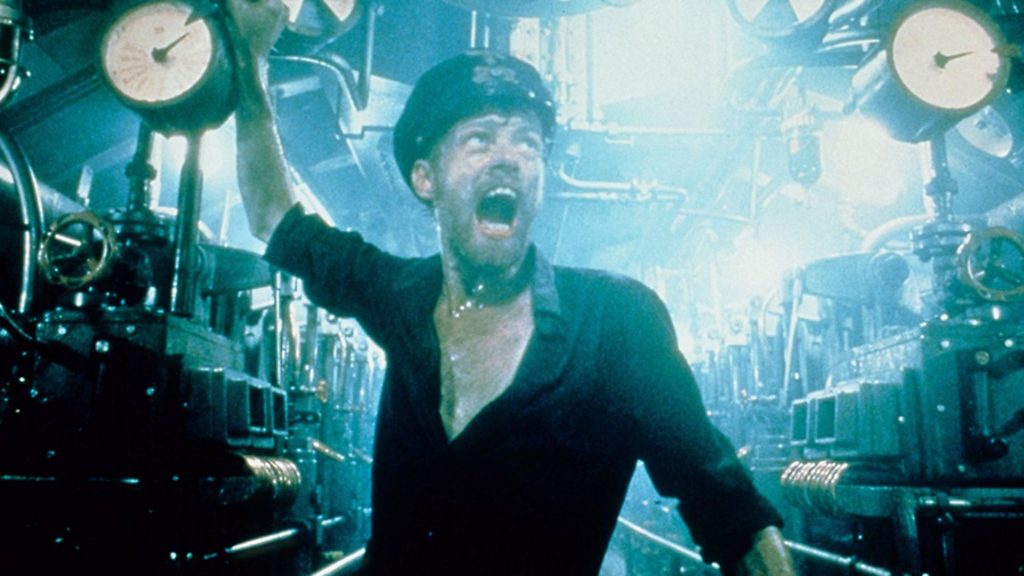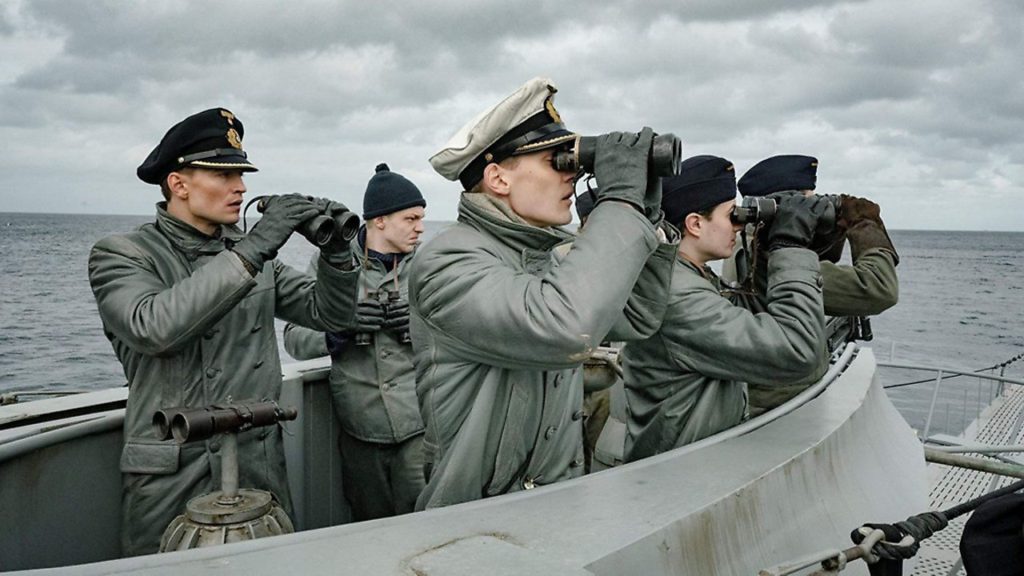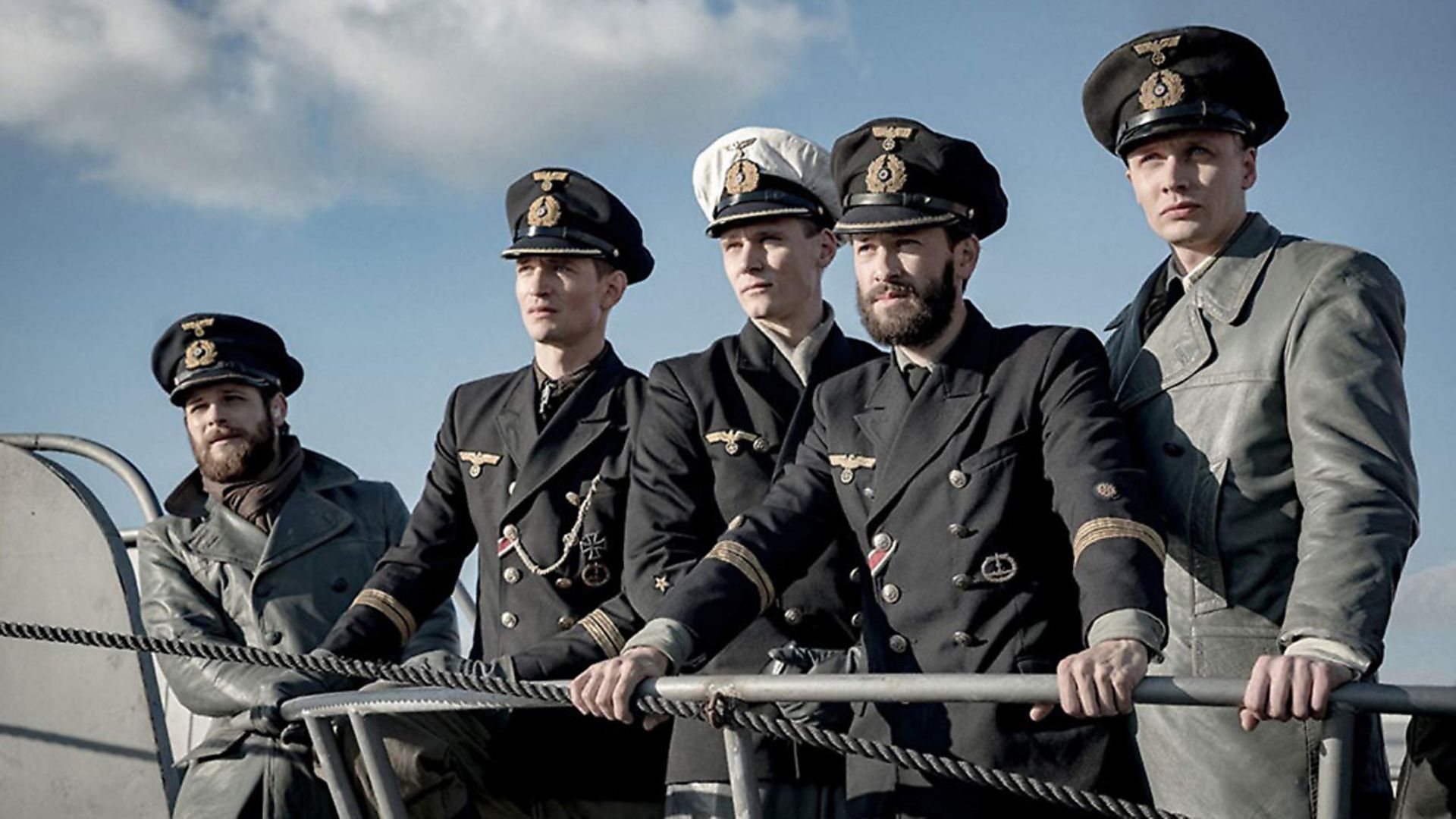The author of Das Boot would have hated the new TV adaptation – but he hated most things. CHARLIE CONNELLY on the troubled mind which could never escape the terror of war beneath the waves.

One morning in the spring of 1983 there was a commotion at the Chicago Museum of Science and Industry, on the shores of Lake Michigan. In the cavernous basement gallery housing the 250-foot long U-505 submarine, captured by the Americans in the Atlantic in 1944, a white-haired man walking with a crutch was railing at parents and children as they examined information boards packed with photographs of American naval ships, aircraft and celebrating soldiers and sailors.
‘You Americans glorify war,’ he was shouting, waving his crutch. ‘You should be teaching young people about the cruelty of war but instead you give them destroyers, planes and aircraft carriers.’
The man with the crutch was in fact a guest of honour at the museum that day, the author Lothar-Günther Buchheim, the recent adaptation of whose book, Das Boot, had filled cinemas across the US like no foreign language film had ever done before.
His response to being escorted into the vast hall was characteristically and irascibly idiosyncratic: expected to coo over the first U-boat he’d seen in the flesh since the war, he instead made straight for the photo displays to protest what he regarded as the glamourisation of conflict, exactly what his book was intended to counter.

Das Boot – the 1973 book and 1981 film – provides about as definitive an account of life on a U-boat during the Battle of the Atlantic short of actually being there. The boredom, the claustrophobia, the tension, the sudden and frantic bursts of activity and the sheer, naked fear have never before or since been captured so viscerally. And the original work was, perhaps unsurprisingly, not the product of a carefree mind.
Buchheim, who died in 2007 at the age of 89, was an abrasive and divisive character to put it mildly. Even his obituary in the German current affairs magazine Der Spiegel called him a ‘dreadful autocrat’ and ‘egomaniac’ who in his later years was ‘irreconcilably misanthropic’.
An old friend recalled of Buchheim after his death that, ‘he always had something to complain about; he was like a dark cloud spreading an aura of terror’. Bewildering reactions to someone who had just died but Lothar-Günther Buchheim wouldn’t have cared. By the end he hated just about everyone and the roots of his intense bitterness might have lain in the wartime experiences of which he wrote.
The original Das Boot novel was largely autobiographical. It told the story of a 1941 Atlantic tour of duty by Type VIIC vessel U-96 through the eyes of Lieutenant Werner, a correspondent from Goebbels’ propaganda ministry sent along to observe the mission in order to write a glowing account of Germany’s mastery of the seas.

What he found during his six weeks in the Atlantic was an extraordinary sense of comradeship, loyalty and calmness under intense pressure, but also a world-weary, iconoclastic disregard for the cause and those giving its orders, among what in other circumstances would have been a young, proud and idealistic crew and its taciturn captain, known only as ‘the Old Man’ (the character is only 30 years old).
Werner, played in the 1981 film by Herbert Grönemeyer, was a thinly-disguised Buchheim who had, in the autumn of 1941, joined the U-96 on patrol during the Battle of the Atlantic under Lieutenant-Commander Heinrich Lehmann-Willenbrock. At the time Germany was running a hugely effective submarine blockade of Atlantic shipping destined for Britain that lasted until well into 1943.
Successful it may have been but it was also incredibly dangerous: of the 41,000 men who served on the U-boats, 26,000 died.
In its wartime career U-96 conducted 11 Atlantic patrols during which it sank 27 ships including, in 1941, three British troop carriers, the Oropesa, Almeda Star and Anselm, with a combined loss of more than 700 lives.

Lehmann-Willenbrock, on whom ‘the Old Man’ – played by Jürgen Prochnow – was based, would become the sixth most successful U-boat commander of the war and was awarded the Knight’s Cross of the Iron Cross with Oak Leaves.
Buchheim produced a starry-eyed, polished account of his 41 days on board for his propagandist employers but he was changed forever by his time in the Atlantic. Sharing a confined space with 50 men for whom there was one toilet and no washing facilities, Buchheim saw humanity at its rawest and most primal. He also spent those 41 days with death as a constant companion with survival rates for U-boat crews significantly less than 50:50.
For most military personnel there is at least a theoretical prospect of escape from calamity, a glimmer of hope however faint, but for the U-boat crews there was no way out, no ejector seat, no shell hole to shelter in. At the mercy of a vengeful enemy and surrounded by nothing but thousands of miles of water, the crew of the U-96 knew exactly the kind of peril they were in. It’s not even as if they were fighting open, honourable battles: theirs was a stealth war, sneaking around catching vulnerable ships unaware and slipping silently away once their work was done.
After the war Buchheim set about trying to establish himself as a painter, art collector and journalist. The son of an artist mother from Weimar he’d studied art in Dresden and Munich prior to the outbreak of the Second World War and showed great promise as a writer too.

As well as producing his own artworks Buchheim amassed a significant collection of German modern and symbolist art and wrote a number of critically-acclaimed monographs, yet still he couldn’t shake the intense, visceral memories of his time on the U-96. As a Kriegsmarine wartime propagandist he’d been out on tours with destroyers and minesweepers but something about the submarine and its crew kept nagging away at him, practically embedded at the core of his being.
Could nothing in everyday life match the sheer unfiltered humanity of all those men confined in a small space, each dependent on the others for his life? Or was it how when the vessel was rocked by depth charges or sank to the floor of the Mediterranean off Gibraltar they’d all looked into the eyes of death and seen it reflected back in the eyes of their comrades?
In the mid-1960s Buchheim wrote a short story about his experiences, Die Eichenlaubfahrt, ‘Oak Leaves Patrol’, named after the award presented to Lehmann-Willenbrock and published in a national newspaper.
Then, in 1973, came the full-length novel, Das Boot, destined to become an international bestseller, as if the author was seeking to work through the traumas of that Atlantic autumn via the nib of his pen.

In its first two years Das Boot sold three million copies in Germany and was subsequently translated into 18 languages. But for all its huge sales at home the book polarised opinion. ‘I was either too hard on the Nazis or too soft on the Nazis, it merely depended on one’s attitude to Nazis,’ Buchheim mused.
For the first time, certainly in Germany, an account of the war portrayed Germans as heroic but flawed, resigned to the fatal incompetence of authority. Reviewers certainly didn’t approve of the ill-discipline portrayed on board and there were serious objections to the level of profanity used by the characters, none of which seemed to discourage readers.
The book was translated into English for a UK edition but when the US publisher Alfred Knopf bought the rights they were not at all happy with the existing translation, finding it reminiscent of ‘second-rate war films’, so publisher Robert Gottlieb and editor-translator Carol Brown Janeway set about a new version.
‘He was a monster,’ recalled Janeway of her dealings with Buchheim, but she recognised the core appeal of the novel and admired the intentions of the writer. The new version sold millions despite the novelty of German soldiers being portrayed as human beings rather than psychopathic automatons.
Additionally, Buchheim’s pacing, which skilfully conveyed the long periods of inactivity and tedium of the voyage, was unfamiliar to readers used to page-turning thrillers. Clearly this was a book that unsettled as much as it enthralled and not everyone approved.
‘One reason why it takes 463 pages to tell this simple story is that each incident is dressed in enough technical detail to earn every reader who stays the course an instant master’s degree,’ complained the New York Times, which also condemned ‘the dullness of a crew with few ambitions higher than the navel’.
Ultimately, the paper found Buchheim’s work to be ‘a straight but unsuccessful bid to soften history’s judgment on 40,000 men who volunteered to wage total war on civilians and were themselves almost totally destroyed, 30,000 of them dying the terrible deaths they richly deserved and their victims did not’.
Despite such snarky reviews – that Times comment was a pretty fair representation of the wider US coverage – the runaway success of the book made a film adaptation inevitable. Although the rights stayed in Germany it was felt that an American slant was needed to make the film more appealing, so Paul Newman was lined up to play ‘the Old Man’ and the action was moved forward to 1942, by which time America had entered the war.
A far less nuanced portrayal of the German crew was being developed when Buchheim pulled the plug on the idea, seeing the film developing into everything he despised. Even when the project was handed on to Wolfgang Petersen the author still feared the dilution of the grim realities he’d described and the subsequent loss of his anti-war message.
‘Can this film, if it lets the moviegoers experience hell in depth, turn them into despisers of the war, or will it simply fascinate them?’ he worried.
Although initially impressed by the production – ‘when I see the bunker sequence (at the U-boat base) I’m once again the young lieutenant walking along the row of basins inside that mammoth, gloomy construction’ – he was soon falling out with Petersen.
Buchheim had assumed he’d be writing the screenplay but he and the director had significantly different visions for the film. Finding the writer stubbornly unwilling to compromise, before long Petersen had to wrest creative control from the story’s creator altogether, prompting Buchheim to distance himself from the project entirely.
‘It’s slipped away from me,’ he said in 1981. ‘Everyone’s calling it my film but it’s nothing of the sort.’
When Das Boot was released to wide acclaim, earning six Oscar nominations and cementing a place among the greatest war films ever made, Buchheim’s constant criticism only exacerbated his growing reputation as a curmudgeon.
It’s safe to say he would have hated Sky Atlantic’s new miniseries, Das Boot, too. The German-made show picks up the story from the original film and book, and also draws on Buchheim’s 1995 work, Die Festung (The Fortress), a 1,500-page epic that follows German soldiers in France towards the end of the war.
The new series is pitched as a sequel to the original, rather than a remake. It begins nine months later in France in 1942 with a new craft and inexperienced crew, as the Battle of the Atlantic begins to turn against Germany now the Allies have cracked the Enigma code. The plot ventures ashore too, with a second narrative strand centred on a morphine-smuggling translator with ties to the Resistance.
The new production has proved as popular on British television as it has in the rest of Europe, with a second series already commissioned. Das Boot is turning into quite the modern franchise, something that would doubtless have enraged his creator.
It’s not even as if he had much to be miserable about: his earnings from the book and the 1981 film helped him concentrate on his artistic acquisitions and the final decades of his life were spent establishing and maintaining a gallery to exhibit his vast collection, which was worth more than $200 million.
He’d intended to set up in his Bavarian home town of Feldafing, but when in the mid-1990s the local authority put the matter to a referendum Buccheim’s plans were comprehensively rejected as locals feared their small, quiet town would become overrun with tourists.
Labelling his fellow citizens ‘gutter rats’, Buchheim took to provoking them as often as he could. Usually this involved signs of his immense wealth, such as being chauffeured in his Rolls-Royce to the local Aldi, where he would bark insults at anyone who came near him as he selected his groceries.
Finally, after 20 years of irritable negotiation with municipalities across Bavaria, the regional authority agreed to finance a 20 million euro building on the shores of Lake Stamberg, designed by the renowned architect Günter Behnisch, whose CV included Munich’s extraordinary Olympic Stadium. At the gallery opening in 2001, Buchheim pronounced it a ‘Bavarian miracle’ then proceeded to tear Behnisch to shreds.
Confined to a wheelchair in his later years and wearing a black patch over his left eye as a result of a medical condition, Buchheim cut an ever more eccentric and misanthropic figure, driving away friends and sympathetic colleagues until even his own son denounced him.
In a hard-hitting book published after his father’s death, titled Buchheim: Artist, Collector, Despot Yves Buchheim alleged not only that his father was far from the anti-Nazi his post-war writing suggested, but also that the notorious skinflint was a serial tax-evader with secret fortunes tied up in Swiss bank accounts.
‘There was no family life, no love, nothing of what one desires as a son from the father,’ Yves wrote. ‘For him I was the cuckoo’s egg one of his wives had left in his nest. He once told me, ‘If this was the mafia I’d have had you shot long ago because you know too much”.
Lothar-Günther Buchheim was a successful, rich and deeply unhappy man. Were those 41 days he spent as a 23-year-old cooped up in a metal tube beneath the Atlantic looking death square in the face behind that unhappiness? When you’ve lived something as intense and visceral as that, normal life must be an awful anti-climax.
Certainly, those weeks defined the rest of his life and plausibly gave him a clear and prescient, if negative, insight into humanity itself. Consider what he told a journalist after his outburst in the Chicago museum in 1983.
‘The history of the Nazis is interesting but you people should know it could happen here in the US too,’ he said. ‘Your racist problems are the same and you are lucky you’ve never known a lot of unemployment at any one time. If a country is down and a guy comes along preaching happiness then explosive things can happen. I hear plenty of fanaticism here.’
Warning: Illegal string offset 'link_id' in /mnt/storage/stage/www/wp-includes/bookmark.php on line 357
Notice: Trying to get property 'link_id' of non-object in /mnt/storage/stage/www/wp-includes/bookmark.php on line 37








